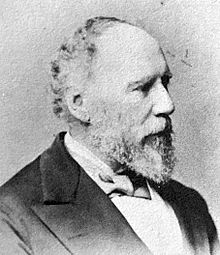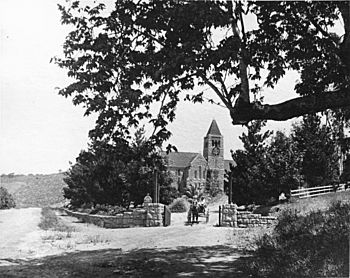Alexander Robert Johnston facts for kids
Quick facts for kids
Alexander Robert Johnston, FRS
|
|
|---|---|
 |
|
| Acting Administrator of Hong Kong | |
| In office 13 June 1842 – 2 December 1842 |
|
| Preceded by | Henry Pottinger |
| Succeeded by | Henry Pottinger |
| In office 22 June 1841 – 1 February 1842 |
|
| Preceded by | Charles Elliot |
| Succeeded by | Henry Pottinger |
| Personal details | |
| Born |
Alexander Robert Campbell-Johnston
14 June 1812 Colombo, Ceylon |
| Died | 21 January 1888 (aged 75) San Rafael Ranch, California, United States |
| Resting place | Brompton Cemetery, London, England |
Alexander Robert Johnston (born Campbell-Johnston, 14 June 1812 – 21 January 1888) was an important British official. He helped manage Hong Kong twice between 1841 and 1842. He was also part of Hong Kong's main governing groups, the Executive and Legislative Councils. In 1845, he became a Fellow of the Royal Society because of his studies on China's nature.
Contents
Early Life and Career
Johnston was born on 14 June 1812 in Colombo, which was then called Ceylon. His father, Sir Alexander Johnston, was a top judge there.
Alexander started working for the British government in 1828 in Mauritius. He worked as a clerk in the Colonial Secretary's office. He stayed in Mauritius until 1833. He then returned to England.
Working in China
In 1833, Johnston became a private secretary to his cousin, Lord Napier. Lord Napier was sent to Canton (now Guangzhou) in China. His job was to manage trade after a big company, the East India Company, lost its special trading rights.
After Lord Napier passed away in 1834, Johnston continued to work for the British trade office. He was promoted several times, eventually becoming Deputy Superintendent of Trade. This meant he worked under Captain Charles Elliot, who was the main British official in China.
Hong Kong's Early Days
During the First Opium War, Johnston helped on a steamship called Nemesis. He was part of an important trip up the Broadway River in 1841.
On 22 June 1841, Captain Elliot made Johnston the acting leader of Hong Kong. This was because Elliot had to join the British forces fighting in the war. Later, Sir Henry Pottinger arrived to take over from Elliot. Pottinger kept Johnston as the acting leader.
Johnston worked hard to develop Hong Kong. He sold land for building homes and businesses. He helped plan important roads like Queen's Road. He also helped build a police station, a record office, and a prison. Barracks for soldiers were built in Stanley. A path for horses was also made towards Aberdeen.
Many people wanted to buy land and build houses. Johnston sent reports to Pottinger about all the progress. However, Pottinger was not happy that Johnston was giving out land without clear instructions from the British government.
Challenges and Recognition
When Pottinger left Hong Kong again on 13 June 1842, Johnston was once more in charge. He was told not to give out more land.
Johnston reported that there was a lot of crime in Hong Kong. Pirates were common, and gangs attacked houses from boats. The jail was full, but Johnston felt he didn't have enough power to punish criminals. These problems showed the British government that they needed to take full control of law and order in Hong Kong.
On 2 December 1842, Pottinger returned. Johnston continued as a trade official. When Pottinger became the first Governor of Hong Kong in 1843, he made Johnston a member of the Executive and Legislative Councils.
Johnston went back to England in October 1843 due to illness. He received a special medal for his service during the war. On 5 June 1845, he was chosen as a Fellow of the Royal Society. This was a great honor for his work studying the natural world in China. He returned to Hong Kong in September 1845. He retired to England in March 1853.
Later Life
On 30 September 1856, Johnston married Frances Ellen Palliser in London. They had eight sons and two daughters. One of their sons, Conway Campbell-Johnston, sadly died with his wife when the ship Lusitania sank. Another son, Malcolm Campbell-Johnston, became a member of the British Parliament. Johnston lived in Suffolk and London, where he was a local judge.
In 1883, Johnston and his wife visited Garvanza, California, in the United States. They bought a large piece of land, over 2,000 acres, and named it the San Rafael Ranch. They planned to use it for farming and building. Their sons managed the ranch. Johnston died there on 21 January 1888.
His wife brought his body back to England, and he was buried in Brompton Cemetery, London. To honor him, she hired an architect to design the Church of the Angels. This church was built in 1889 and is now a historic landmark in Pasadena. It is the most important building remaining from the Campbell-Johnston Ranch.
Namesakes
Several places are named after Alexander Robert Johnston:
- Johnston House, now called the Former French Mission Building, in Central, Hong Kong
- Johnston Road, a street in Wan Chai, Hong Kong
- Mount Johnston, a mountain on Ap Lei Chau, Hong Kong
- Johnston Lake, in Pasadena, California, United States
See Also
- List of heads of Hong Kong



